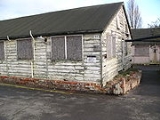
Hut 6
Encyclopedia

Bletchley Park
Bletchley Park is an estate located in the town of Bletchley, in Buckinghamshire, England, which currently houses the National Museum of Computing...
tasked with the solution of German Army and Air Force Enigma machine
Enigma machine
An Enigma machine is any of a family of related electro-mechanical rotor cipher machines used for the encryption and decryption of secret messages. Enigma was invented by German engineer Arthur Scherbius at the end of World War I...
ciphers. Hut 8
Hut 8
Hut 8 was a section at Bletchley Park tasked with solving German naval Enigma messages. The section was led initially by Alan Turing...
, by contrast, attacked Naval Enigma. Hut 6 was established at the initiative of Gordon Welchman
Gordon Welchman
Gordon Welchman was a British-American mathematician, university professor, World War II codebreaker at Bletchley Park, and author.-Education and early career:...
, and was run initially by Welchman and fellow Cambridge mathematician John Jeffreys.
Welchman's deputy, Stuart Milner-Barry
Stuart Milner-Barry
Sir Stuart Milner-Barry KCVO, CB, OBE was a British chess player, chess writer, World War II codebreaker and civil servant. He represented England in chess both before and after World War II...
, succeeded Welchman as head of Hut 6 in September 1943, at which point over 450 people were working in the section.
Hut 6 was partnered with Hut 3, which handled the translation and intelligence analysis of the raw decrypts provided by Hut 6.
Location
Hut 6 was originally named for the building in which the section was located. Welchman says the hut was 60 ft (18m) long by 30 ft (9m) wide, with two large rooms at the far end - and no toilets. Staff had to go to another building.As the number of personnel increased, the section relocated to additional buildings around Bletchley Park, but its name was retained, with each new location also being known as 'Hut 6'. The original building was then re-named 'Hut 16'.
Personnel
- James Macrae AitkenJames Macrae AitkenJames Macrae Aitken was a Scottish chess player.In 1938 he received a PhD from Edinburgh University on the topic of 'The Trial of George Buchanan Before the Lisbon Inquisition'.He was Scottish champion in 1935, 1952, 1953, 1955, 1956, 1957, 1958, 1960, 1961 and 1965, the latter jointly with PM...
- Hugh AlexanderConel Hugh O'Donel AlexanderConel Hugh O'Donel Alexander, CMG, CBE was an Irish-born British cryptanalyst, chess player, and chess writer. He worked on the German Enigma machine at Bletchley Park during World War II, and was later the head of the cryptanalysis division at GCHQ for over 20 years...
, member February 1940 - March 1941 (later head of Hut 8Hut 8Hut 8 was a section at Bletchley Park tasked with solving German naval Enigma messages. The section was led initially by Alan Turing...
) - Asa Briggs, member of the Watch
- John HerivelJohn HerivelJohn W. Herivel was a British science historian and former World War II codebreaker at Bletchley Park.As a codebreaker concerned with Cryptanalysis of the Enigma, Herivel is remembered chiefly for the discovery of what was soon dubbed the Herivel tip or Herivelismus...
, arrived at Bletchley Park in January 1940; discoverer of the "Herivel Tip", later worked in administration in the NewmanryNewmanryThe Newmanry was a section at Bletchley Park, the British codebreaking station during World War II. Its job was to develop and employ machine methods in Cryptanalysis of the Lorenz cipher. The Newmanry was named after its founder and head, Max Newman...
. - John Jeffreys, initially in charge of the Hut with Welchman until May 1940 (died in early 1941)
- Stuart Milner-BarryStuart Milner-BarrySir Stuart Milner-Barry KCVO, CB, OBE was a British chess player, chess writer, World War II codebreaker and civil servant. He represented England in chess both before and after World War II...
, member from early 1940 to the end of the war; head from autumn 1943 - David ReesDavid Rees (mathematician)David Rees ScD Cantab, FIMA, FRS is an emeritus professor of pure mathematics at the University of Exeter, having been head of the Mathematics / Mathematical Sciences Department at Exeter for many years....
- Bob RoseveareBob RoseveareRobert Arthur Roseveare was a codebreaker at Bletchley Park during World War II and later a schoolteacher.He was born at Repton, Derbyshire where his father, Sir Martin Roseveare, taught at Repton School...
mathematician, schoolteacher - Derek TauntDerek TauntDerek Roy Taunt was a British mathematician who worked as a codebreaker during World War II at Bletchley Park....
—arrived at Bletchley ParkBletchley ParkBletchley Park is an estate located in the town of Bletchley, in Buckinghamshire, England, which currently houses the National Museum of Computing...
in August 1941 - Gordon WelchmanGordon WelchmanGordon Welchman was a British-American mathematician, university professor, World War II codebreaker at Bletchley Park, and author.-Education and early career:...
, initially in charge of the Hut with Jeffreys, becoming official head of the section until Autumn 1943 (later Assistant Director of Mechanisation at Bletchley Park)
- Madge Allen
- Dennis Babbage
- Clarence Barasch, American Observer to British Intelligence
- Edna Garbutt, member of A watch
- Reginald H Parker, discoverer of "Parkerismus"

